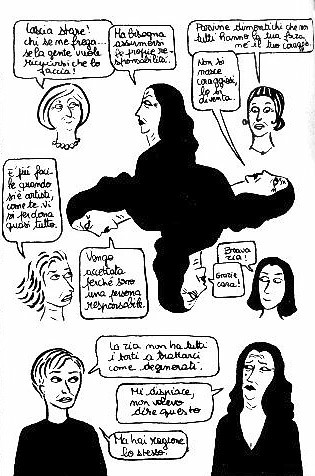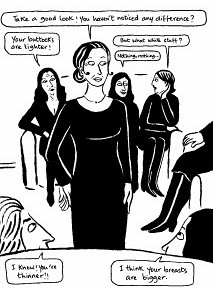Oh my god. A story by Ernest Hemingway that I actually like and admire as skillfully crafted? Who’d ever’ve thought?
Frederick Busch, the man who wrote a little critique of this story that the anthology included after the piece, lauds Hemingway’s dialogue in this story. Eh. The content is excellent, I will agree, but I always take issue with his dialogue for being not quite believable. For example, “‘And we could have all this,’ she said. ‘And we could have everything and every day we make it more impossible.’” People don’t talk like that — people on Aaron Spelling shows talk like that. My arguments with my S.O. usually go something like this: “Why are you being such an ass?” “Why are you being such a bi–” Glare. “I didn’t say it.” “But you almost did.” “I’m sorry. It’s difficult to unlearn the first 23 years of my life.” “It isn’t easy for me either.” “I didn’t say that it was!” “And I wasn’t saying that you were saying that!” And so on. And I will always critique Hemingway’s use of “it.” I know, blah blah blah, prominent authors can write as they like and break the rules set for the common person, but antecedent-less pronouns are annoying and sometimes confusing.
From the first few sentences of the story, Hemingway sets the emotional landscape of the story.
The hills across the valley of the Ebro were long and white. On this side there was no shade and no trees and the station was between two lines of rails in the sun.
That description of the landscape introduces the important image of “sides” that Hemingway uses throughout the story to emphasize “the man” and “the girl” being at odds about something. (Though never stated explicitly, the reader eventually realizes that the couple is arguing about the woman having an abortion.) The image of the station having “no shade and no trees” and being “between two lines of rails in the sun” presents the venue of the lovers’ confrontation as very vulnerable, unprotected, because of its exposure to the sun, and yet almost like a prison, considering the station being trapping between the two rails. Both ideas suggest an alienation of sorts, relating the setting to the couple, who are alienated from each other, and to the woman, who is also alienated culturally by not speaking the native language.
Busch writes in his critique that the woman’s “lover or husband wants the fetus aborted, and she wants to keep him.” Re-reading that sentence I am unclear whether Busch is referring to the lover or the fetus with that “him.” Though I do agree with Busch that the man seems to have an unequal amount of power over the woman. Even in the appositives that Hemingway uses to refer to the characters: the male is “the man” but the female is “the girl.” The man also has a power through language — he speaks Spanish — that the woman does not. And his judgement seems to control the woman’s imagination. The woman makes the observation that the hills “look like white elephants” early in the story. When the man seemingly dismisses her observation as frivolous, she tempers her opinion to, “They don’t really look like white elephants. I just meant the coloring of their skin through the trees.”
Throughout the story, the woman continues to contemplate the hills, the trees, the river, and other aspects of the landscape across from the station. The image of the hills resembles the shape of a pregnant woman’s body, and the earth is usually a symbol of fertility and reproduction. Her comment comparing the hills to white elephants – rare and somewhat mystical animals – suggests that the woman’s feelings toward her pregnancy are positive. Hemingway does not give many indicators of the woman’s — or the man’s, for that matter — tone of voice. But I don’t read their conversation as the woman wanting to please the man in order to keep him, rather debating her options should she do something that would not please him, such as keeping the baby. As I said before, the woman seems very alienated in this environment. She is dependent upon the man for both communication and sustenance (of a sort) during this interlude at the station. She may not feel as though she can do as she wants with her body, and have the baby, if it risks separating her from the man, who seems crucial to her survival.
The girl did not say anything.
“I’ll go with you and I’ll stay with you all the time. They just let the air in and then it’s all perfectly natural.”
“Then what will we do afterward?”
“We’ll be fine afterward. Just like we were before.”
“What makes you think so?”
“That’s the only thing that bothers us. It’s the only thing that’s made us unhappy.”
The girl looked at the bead curtain, put her hand out and took hold of two of the strings of beads.
“And you think then we’ll be all right and be happy.”
“I know we will.”
…
“And if I do it you’ll be happy and things will be like they were and you’ll love me?”
“I love you now. You know I love you.”
“I know. But if I do it, then it will be nice again and if I say things are like white elephants, and you’ll like it?”
When the man mentions the abortion, the woman does not seem to react to the idea favorably. Her attitude changes suddenly after she “look[s] at the bead curtain, put[s] her hand out and [takes] hold of two of the strings of beads.” That bead curtain is featured earlier in the story when she asks the man what the writing on the curtain — “Anis del Toro” — means. The curtain seems to be a reminder of her dependence upon him and, thus, causes her reconsideration.
Hemingway does not present the man in a very favorable light. He acts selfishly, pleading with the woman to have an abortion because he doesn’t “want anyone but [her].” He also seems dense. He makes an observation about the travelers in the train station “waiting reasonably for their trains.” This thought suggests that he thinks the woman is not acting “reasonably.” He continues to urge her to have an abortion, telling her that the operation is “simple,” seemingly unaware and unconcerned about the emotional complexity of an abortion for a woman.
I cannot decide the significance of the ending. The last of the conversation that precedes the man going into the station suggests an increased distance between the two, especially on the part of the woman as she “looked across at the hills on the dry side of the valley.” So I cannot decide if her final comment of “There’s nothing wrong with me. I feel fine,” is in defiance or compliance with the man’s wishes. By saying that “There’s nothing wrong with [her]” she might be defending her desire to keep the pregnancy; or, she might be agreeing to continue on her journey with the man. Does the reader really know for certain what her ultimate decision is? The story takes place while the couple is waiting for a train, which suggests that this woman has the forty minutes until the train comes to decide if she will stay with the hills and the river and all of those symbols of life and fertility and keep the pregnancy or board the train and have the abortion to keep the man.
 The passion for these songs espoused by the artists is readily apparent in all of the tracks, but unfortunately their love of the material does not always produce the greatest results.
The passion for these songs espoused by the artists is readily apparent in all of the tracks, but unfortunately their love of the material does not always produce the greatest results.

 This blog contains what I think about movies, TV, short stories and crap like that. This blog is chock-full o' spoilers, so be warned. Though I don't tend to write about anything current, so I doubt there's much here to spoil anybody.
This blog contains what I think about movies, TV, short stories and crap like that. This blog is chock-full o' spoilers, so be warned. Though I don't tend to write about anything current, so I doubt there's much here to spoil anybody.